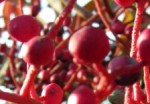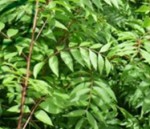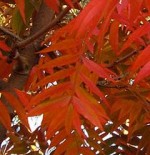 Chinese pistacihe is a deciduous tree native to the Philippines, and central and western China where it is a popular garden plant. It is a member of cashew family, Anacardiaceae, that also includes mango, poison ivy, sumac, and smoke tree. With gray-green bark that exfoliates to show salmon colored inner bark, the tree has an oval rounded canopy, a stout trunk and heavy, spreading branches. The feathery, pinately compound leaves are up to ten inches long and have ten or twelve leaflets up to four inches long. They are red when they open, in the spring before turning bright green and then vivid orange or red in the fall. The foliage is fragrant and more dense on male trees. Panicles of greenish male and female flowers appear in spring on separate trees and female flowers give way in fall to small decorative inedible fruits 1.4 inch long, containing a single seed. Plants tolerate poor soils, drought, heat, desert conditions, seacoast conditions and air pollution, and are a good choice for shade, street, patio, or specimen tree.
Chinese pistacihe is a deciduous tree native to the Philippines, and central and western China where it is a popular garden plant. It is a member of cashew family, Anacardiaceae, that also includes mango, poison ivy, sumac, and smoke tree. With gray-green bark that exfoliates to show salmon colored inner bark, the tree has an oval rounded canopy, a stout trunk and heavy, spreading branches. The feathery, pinately compound leaves are up to ten inches long and have ten or twelve leaflets up to four inches long. They are red when they open, in the spring before turning bright green and then vivid orange or red in the fall. The foliage is fragrant and more dense on male trees. Panicles of greenish male and female flowers appear in spring on separate trees and female flowers give way in fall to small decorative inedible fruits 1.4 inch long, containing a single seed. Plants tolerate poor soils, drought, heat, desert conditions, seacoast conditions and air pollution, and are a good choice for shade, street, patio, or specimen tree.

Type: Deciduous tree
Outstanding Feature: Fall coloration; decorative fruit
Form: Rounded canopy
Growth Rate: Slow
Bloom: Inconspicuous greenish male and female flowers in panicles on different trees in spring
Size: 30-60’ H x 30-60’ W

Light: Full sun; tolerates some shade
Soil: Prefers deep, moist, well-drained soil but tolerates less.
Hardiness: Zones 6-9
Care: Prune in winter when young to encourage good form.
Pests and Diseases: Relatively free but may be susceptible to verticillium wilt.
Propagation: Seed with cold stratification; half-ripe cuttings from young trees in summer